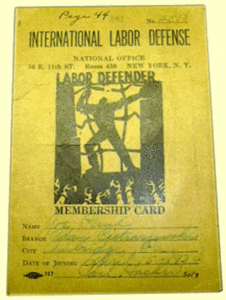
ILD membership card
*On this date, in 1925, the International Labor Defense (ILD) was formed. IDL was a diverse legal advocacy organization supporting American labor.
Economic disputes have been legally contested since the 19th-century organized labor movement in America began. Sometimes, an employer or government has gone to court to terminate strike actions or to seek prosecution for alleged malefactors for physical violence or property damage resulting from such turmoil. Employers' use of the injunction to prohibit specific actions and its enforcement by the courts occasionally resulted in groups of defendants being embroiled in the costly legal system for union activities.
The Snow Riot and the Pullman Strike of 1894, which brought about the trial and imprisonment of the officers of the American Railway Union, are examples. The syndicalist Industrial Workers of the World was subject to particularly intense legal pressure, which was sometimes framed as "free speech" actions and, in other situations, less ambiguously, as legal actions against union organizers and activists for their economic activities. The Industrial Workers of the World established a legal advocacy organization called the General Defense Committee (GDC) to defend its core activists and their activities from a systematic legal attack. It raised funds and coordinated the union's legal defense efforts.
Government efforts to silence and jail conscientious objectors in the early 1900s resulted in more than 2,000 prosecutions. These cases led to the formation of a legal defense organization for these defendants called the Civil Liberties Bureau, which continues today as the American Civil Liberties Union (ACLU). The ILD was active in the anti-lynching movements and prominently participated in the legal appeals of the Scottsboro Boys case in the early 1930s. Its work contributed to the appeal of the Communist Party among African Americans in the South. In addition to fundraising for defense and assisting in defense strategies, from January 1926, it published Labor Defender, a monthly illustrated magazine that achieved wide circulation.
In 1946, the ILD merged with the National Federation for Constitutional Liberties to form the Civil Rights Congress, a new legal defense organization of the Communist Party USA. It was intended to expand its appeal, particularly to African Americans in the South. In several prominent cases where many were sentenced to death, the CRC campaigned on behalf of black defendants. It had some conflict with former allies, such as the NAACP, and became increasingly isolated. Due to federal government pressure on organizations like the CRC, it is considered subversive and has become less effective in representing defendants in criminal justice cases.
As it began to dissolve, Black leaders expanded the activities and reach of the American Civil Rights Movement. In 1954, in a case managed by the NAACP, the U.S. Supreme Court ruled in Brown v. Board of Education that segregation of public schools was unconstitutional. The CRC dissolved in 1956 when the American Civil Rights Movement expanded its activities.